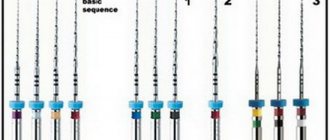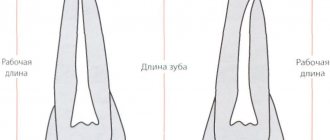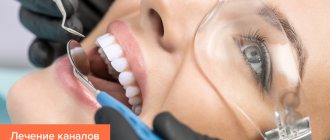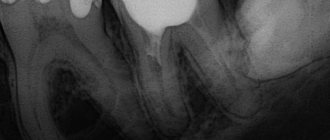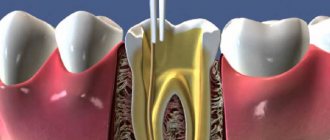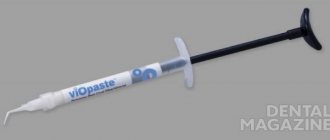Giuseppe Cantatore University of Verona (Italy). Department of Endodontics. Assistant professor.
In a classic study published in 1985, Bystrom et al. compared the sterilizing effectiveness of three different methods of endodontic treatment of infected canals and found that mechanical treatment in combination with irrigation with saline solution ensures canal sterility in 20% of cases, while replacing NaCl with a 5% sodium hypochlorite solution leads to canal sterility in 50% of cases. cases, and the addition of the latter scheme with a single temporary filling of the canal with calcium hydroxide increases the percentage of canal sterilization to 97%. Does this mean that when treating infected root canals, temporary filling with medicated paste is required in all cases? More than 15 years have passed since the Bystrom et Al study; Today we know much more about the properties of microorganisms associated with pulp-periodontal pathology: from virulence to mobility, from the ability to penetrate dentinal tubules to sensitivity to various antiseptics. 15 years of research experience have shown that many irrigation solutions have pronounced bactericidal activity against microorganisms such as enterococcus faecalis or candida, which are resistant to calcium hydroxide or chlorophenol. In this article, we will discuss in 7 points how to improve the root canal irrigation procedure, using the right products in the right sequence, in order to reduce the need for additional medicinal treatment of the canals between visits.
Key Factors for Effective Cleaning and Irrigation of the Root Canal System
1. Careful diagnosis of existing pulp-periodontal pathology
2. Taking into account the condition of the tooth tissues and the complexity of the anatomy of the root canal system 3. Removal of the endodontic smear layer 4. Compliance with indications when choosing means for irrigation 5. Optimization of the active components of the irrigation solution 6. Correct sequence of application of the irrigation solution during root canal treatment 7. Mandatory costs of at least 5 minutes for irrigation before filling
Contraindications and side effects
Contraindications to the use of ethylenediaminetetraacetic acid:
- age under 18 years;
- kidney disease;
- individual intolerance to the components included in the drug;
- period of childbearing and breastfeeding;
- liver diseases.
Side effects:
- disruption of the heart;
- diarrhea;
- disruption of the gastrointestinal tract;
- hypercalcemia – a sharp decrease in calcium levels in the body.
Effects that require urgent hospitalization may occur:
- vomit;
- diarrhea;
- itching;
- dyspnea;
- arrhythmia.
EDTA food additive – use in food
The E385 additive is introduced into food formulations as a preservative or stabilizer in order to prevent unwanted oxidative processes catalyzed by metal ions. EDTA slows down the formation of benzene (a carcinogen) in soft drinks containing sodium benzoate and ascorbic acid.
EDTA calcium-sodium salt can be used as a stabilizer and antioxidant in the production of oil and fat products (margarines and mayonnaises), as a preservative in the production of canned vegetables, mushrooms, fish, canned seafood and legumes.
EDTA salt is used for medical purposes (to neutralize the effects of metal poisoning, such as mercury and lead), in the production of various cosmetics as a preservative.
In detergents, cleaning products and personal care products, EDTA salts act as a stabilizer.
Currently, EDTA is used all over the world in various industries, but when it gets into water or soil, it very slowly turns into simpler substances and, as a result, can pose a danger to the environment.
How much do you trust this dietary supplement? Vote using a 5-point system (from 1 to 5 points).
Recently Added Products
Juiced power drink green apple blastXS TM
Semi-smoked sausage “Krakow special”Rossiyanka TM
Cappuccino based on chicory and fructoseCikorich TM
Mixed caramel pops filled with orange lime cola flavors Confectionery factory Bogatyr TM
Mini Mints without sugar with watermelon flavorHalls TM
Formula 1 Evening cocktailHerbalife TM
Milk chocolate with milk filling Nelly non-alcoholic highly carbonated drink Fanta TM
pharmachologic effect
It exhibits the property of an antidote when cyanogen chloride, hydrocyanic acid or volatile cyanide compounds enter the body. In addition, activity is observed against the following toxic substances:
- mercury;
- lead;
- zinc;
- arsenic;
- cobalt.
It has the ability to bind toxic particles in the bloodstream and then remove them along with urine and feces.
Being an antioxidant, it prevents oxidation processes. Other useful properties include:
- stimulation of immunity;
- normalization of cholesterol and glucose levels;
- blood thinning;
- restoration of physiological, biochemical processes in the internal systems of the body.
In pharmaceuticals, it is added to the composition of many drugs in order to enhance the therapeutic properties of the latter and increase the bioavailability of the active components.
Application
The annual global production of the EDTA compound exceeds 80 tons.
The main consumer is the food industry.
Most often, the E 385 additive is used in the production of mayonnaise (75 mg/kg) and other sauces containing iron-rich bird eggs. EDTA prevents metal ions from starting the oxidation mechanism.
In Russia, the antioxidant is allowed in the following products:
- margarines with reduced fat content (100 mg/kg);
- vegetables, mushrooms, canned in metal cans or covered with metal lids (250 mg/kg);
- canned fish, frozen crabs (75 mg/kg).
The Codex Alimentarius allows use in frozen French fries (100 mg/kg), canned crab meat (250 mg/kg).
The food additive E 385 is in demand among manufacturers of carbonated soft drinks. A mixture of sodium and potassium benzoates (E 211 and E 212) and ascorbic acid (E 300), which is generously supplied with Pepsi-Cola, Sprite and similar liquids, forms the most dangerous carcinogen benzene. The action of the toxic substance is designed to neutralize ethylenediaminetetraacetate.
Complexon II is used by brewers to process intoxicating drinks. The synthetic substance solves two problems at once: it promotes increased foaming and extends shelf life.
In second place in terms of the volume of use of the E 385 additive is medicine. A number of drugs for the treatment of skin, ophthalmological and urological diseases contain salts of heavy metals (mercury dioxide, copper and zinc sulfates). Their accumulation in the liver and kidneys can cause severe poisoning.
Ethylenediaminetetraacetate neutralizes hazardous substances and promotes their elimination from the body.
The cosmetics industry uses EDTA in skin creams, soaps, and shampoos. Ethylenediaminetetraacetate, by binding metal ions, increases foaming, softens the aqueous phase, and enhances the effect of other antioxidants.
Food additive E 385 is approved for use in Russia, EU and EAEU countries, Canada, and the USA. The status of the substance in Ukraine is unclear.
alternatives
Interest in environmental safety has raised concerns about biodegradability in aminopolycarboxylates such as EDT. For example, according to the 28-day ISO 7827 test, the Austrian pulp and paper industry must use chelating agents that have biodegradation levels greater than 70% or 80% (after 28 days). Increased interest in safety has led to the development and research of alternative chelating ligands that can still bind strongly to metal ions, but also have higher biodegradability and lower nitrogen content.
Iminodisuccinic acid (IDS)
Commercially used since 1998, iminodisuccinic acid (IDS) is approximately 80% degraded after just 7 days. IDS binds calcium exceptionally well and forms stable compounds with other heavy metal ions. In addition to having lower toxicity after chelation, IDS production is environmentally friendly. Specifically, IDS is impaired by the use of IDS epimerase and C-N lyase, found in Agrobacterium tumefaciens
(BY6), which can be assembled on a large scale. Moreover, the reaction catalyzed by both enzymes does not require any cofactors and thus can be carried out directly.
polyaspartic acid
Polyaspartic acid, as an IDS, binds to calcium and other heavy metal ions. It has a higher value of 7.2 meq/g than does EDTA, which has only 6.0 meq/g. While it has a higher theoretical capacity, in practical applications it has low efficiency in solutions of lower ion concentrations . It has many practical uses including corrosion inhibitors, additives, wastewater and agricultural polymers. Acid-based Polyaspartic laundry detergent was the first laundry detergent in the world to receive the EU flower eco-label.
Ethylenediamine-N,N'-disuccinic acid (EDDS)
As a structural isomer of EDTA, ethylenediamine- N
,
N
-disuccinic acids' (EDDS) can exist as three isomers: (
S
,
S
), (
R
,
S
)/(
S
,
R
) and (
R
,
R
), but only
the S
,
S
isomer is easily biodegradable decomposition. EDDS exhibits a surprisingly high biodegradation rate of 83% within 20 days. Biodegradation rates are also modified by different chelated metal ions. For example, complexes of lead and zinc with EDDS have relatively the same stability, but the lead complex decomposes more efficiently than the zinc complex. As of 2002, EDDS was commercially available in Europe on a large scale with an estimated increase in demand rate of about 15% each year.
Methylglycinediacetic acid (MGDA)
Methylglycinediacetic acid (MGDA) is obtained from glycine. MGDA has a high biodegradation rate of over 68%, but unlike many other chelating agents can degrade without the help of adapted bacteria. Additionally, unlike EDDS or IDS, MGDA can withstand higher temperatures while maintaining high stability, as well as the entire pH range. As a result, the chelating strength of MGDA is stronger than that of many commercial chelating agents.
Why do people take ethylenediaminetetraacetic acid (EDTA)?
Sometimes ethylenediaminetetraacetic acid (EDTA) is prescribed by doctors to cleanse the blood of toxic metals such as lead. Doctors have used this molecule for decades to treat heavy metal poisoning. In this case, ethylenediaminetetraacetic acid is recommended to be administered intravenously.
Ethylenediaminetetraacetic acid is also an ingredient in some prescription cancer drugs.
Supplement manufacturers claim that over-the-counter forms of EDTA can be taken orally to help cleanse the body and promote normal gastrointestinal function. These properties of EDTA have not yet been scientifically proven.
Some also touted EDTA as helping to combat clogged arteries (atherosclerosis) by removing cholesterol and plaque from the blood. Again, no scientific studies have been conducted to prove these properties of ethylenediaminetetraacetic acid.
Some people take EDTA to treat the following conditions:
- Diabetes
- Peripheral blood vessel diseases
- Alzheimer's disease
- Cardiovascular disease
However, there is no scientific evidence yet confirming the healing properties of ethylenediaminetetraacetic acid in the treatment of the above-mentioned diseases. Recent research shows that EDTA is not a useful drug, and in some cases, taking EDTA can be dangerous. The optimal dosage of the drug has not been established. Product composition and quality can vary widely, making it difficult to determine a standard dose.
Main manufacturers
In Russia, sodium calcium ethylenediaminetetraacetate is produced by the State Unitary Enterprise “Experimental Plant of the Academy of Sciences of the Republic of Belarus” (Bashkortostan). The small volume of production does not allow satisfying the demand for the food additive.
The group offers EDTA food additive from the manufacturer Jan Dekker (Netherlands).
The domestic market is formed by Chinese suppliers:
- Humica Weihai International. The chemical enterprise specializes in the production of antioxidant E 385 and has its own scientific laboratory;
- Hangzhou Anxing Trade, a company operating since 1993, supplies products to 40 countries;
- Shijiazhuang Xinlongwei Chemical, a company part of the Landchem chemical corporation, has international product quality certificates.
Despite the low toxicity of the food additive E 385, it should be treated with caution. The substance has exactly the opposite properties: it can both remove heavy metals from the body and promote their accumulation and absorption into the blood. The effect depends on the amount and duration of use.
Environmental organizations are also sounding the alarm. Once in the surrounding space, EDTA does not break down into simple components, like other chelate compounds. The safety of the ecological system is at risk.
Principles of coordination chemistry
Metal-EDTA chelate as found in Co(III) complexes.
The structure shows that the EDTA 4-ligand does not completely encapsulate Fe(III), which is seven-coordinate.
In coordination chemistry, EDTA 4- is a member of the aminopolycarboxylic acid family of ligands. EDTA 4- usually binds to the metal cation through its two amines and four carboxylates. Many of the resulting coordination compounds adopt octahedral geometries. Although of particular importance for its application, these octahedral complexes are chiral. Cobalt(III) anion has been resolved into enantiomers. Many EDTA 4- complexes take on more complex structures, resulting either in the formation of additional bonds with water, i.e.
seven coordinates of the complexes, or the displacement of one carboxylate arm of water. Iron (III) complex EDTA seven-coordinate. Early work on the development of EDTA was carried out by Herold Schwarzenbach in the 1940s. EDTA forms particularly strong complexes with Mn (II), Cu (II), Fe (III), Pb (II) and Co (III).
Several features of EDTA complexes are relevant to its applications. Firstly, due to its high dentacy, this ligand has a high affinity for metal cations:
3+ + H 4 EDTA ⇌ — + 6 H 2 O + 4 H +
K
eq = 10 25.1
Written in this way, the equilibrium factor indicates that metal ions compete with protons for binding to EDTA. Since metal ions are widely covered by EDT, their catalytic properties are often suppressed. Finally, since EDTA 4- complexes are anionic, they tend to be very soluble in water. For this reason, EDTA is capable of dissolving deposits of metal oxides and carbonates.
V p K
and the values of free EDTA are 0, 1.5, 2, 2.66 (deprotonation from four carboxyl groups) and 6.16, 10.24 (deprotonation from two amino groups).
Environmental Consequences
Abiotic degradation
EDT is in such widespread use that questions have been raised whether it is a persistent organic pollutant. While EDTA serves many positive functions in a variety of industrial, pharmaceutical and other applications, EDTA's longevity can create serious problems in the environment. EDTA degrades slowly. It occurs mainly abiotically in the presence of sunlight.
The most important process for the elimination of EDTA from surface waters is direct photolysis at wavelengths below 400 nm. Depending on light conditions, the photolysis half-life of iron(III)EDTA in surface waters can range from as low as 11.3 minutes to over 100 hours. Degradation of FeEDTA, but not EDTA itself, produces iron complexes of triacetate (ED3A), diacetate (EDDA), and monoacetate (EDMA) - 92% of EDDA and EDMA decomposes in 20 hours with ED3A showing significantly higher resistance. Many environmentally abundant types of EDTA (eg Mg 2+ and Ca 2+ ) are more persistent.
biological decay
In many industrial water treatment plants, EDT elimination can be achieved at approximately 80% using microorganisms. The resulting byproducts are ED3A and iminodiacetic acid (IDA)—suggesting that both the backbone and acetyl groups are attacked. Some microorganisms have even been found to form nitrates from EDTA, but degrade optimally under moderately alkaline conditions pH 9.0-9.5.
Several bacterial strains isolated from wastewater treatment plants effectively degrade EDTA. Specific strains include Agrobacterium radiobacter
ATCC 55002 and sub-clades of Proteobacteria like BNC1, BNC2 and strain DSM 9103. The three strains have similar aerobic respiration properties and are classified as Gram-negative bacteria. Unlike photolysis, the chelated species is not exclusively iron(III) so as to be degraded. Rather, each strain uniquely consumes varying metal-EDTA complexes through multiple enzymatic pathways. Agrobacterium radiobacter only degrades Fe(III), while EDTA BNC1 and DSM 9103 are unable to degrade iron(III)EDTA and are more suitable for calcium, barium, magnesium and manganese(II) complexes. EDTA complexes require dissociation before degradation.
Myths and legends
There are several myths about the use of tetrasodium salt in dentistry:
- Ethylenediaminetetraacetic acid does not have antiseptic properties in dentistry, so it should not be used. This is absolutely not true, this component has a limited antiseptic that allows you to remove calcium from any structure.
- EDTA has no effect on the canals of the teeth. This is not true, since the mouths of the canals in most cases are closed from the outer eye, which is protected by the pulp, and this remedy dissolves it and restores access to diagnosing the canals.
- Gels containing EDTA do not make the work of dental instruments easier. Not true. These gels work on an already softened surface, facilitating the work of hand tools, since their rotation speed is much lower than that of automatic devices.
In dentistry, the use of ethylenediaminetetraacetic acid does not cause any harm, but helps soften any tissue without exposure to devices. But if you use tetrasodium salt on your own, it can cause harm to your health.
